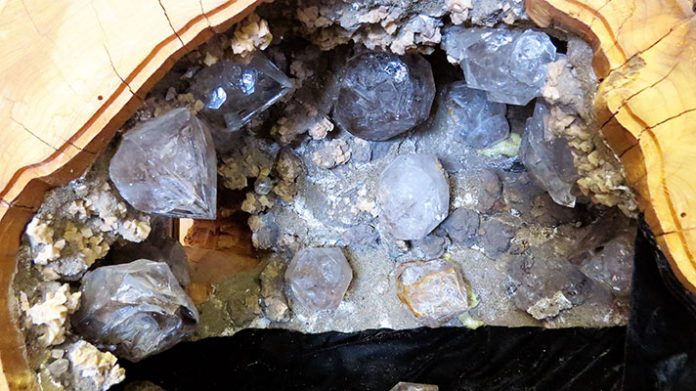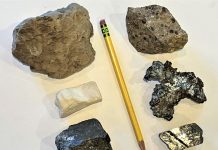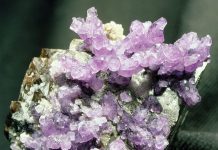
Story by Jim Landon
Back in 1970, when I was a fresh graduate from a teachers college in Nebraska, I landed my first teaching position in Maspeth, Queens, New York. During the two years I taught there, I had two opportunities to travel to upstate New York and dig for Herkimer diamonds. It was my introduction to the rockhounding hobby, which continues to fill my life with unending adventures and discoveries.

My forays took me to what is still a popular fee-collecting site, called the Ace of Diamonds (www.Herkimerdiamonds.com). This collecting locality outside of Herkimer, New York, lies on the west end of the Little Falls dolomite formation. It has all of the amenities a rockhound would need to successfully dig for and collect these beautiful, doubly terminated quartz crystals.
During the two weekends that I dug at their place, I was fortunate to be able to uncover two large pockets of crystals. Both were nearly half full of wet, sticky, gray, decomposed-dolostone clay. Pieces of the pocket wall with large crystals had detached from the ceiling and could be seen partially embedded in the clay.
Removing the clay and crystal contents from the cavity was like trying to scoop putty. The tips of my bare fingers suffered numerous cuts from sharp crystal shards and the rough dolomite and druzy crystal crust that formed the inner walls of the pockets. I guess a blood sacrifice is of little consequence for the bounty of crystals that came out of those two pockets.
When the pocket clay was screened, I found that it contained hundreds of smaller, extremely bright and clear crystals. I still have a scar on the tip of my nose and a chipped front tooth as a reminder of what it was like to get hit in the face with a broken chisel. That was back when I was young and dumb.
The Ace of Diamonds has a campground and a mine store that rents and sells tools. They have a fabulous collection of Herkimer diamonds that have been found in their quarry over the years, as well as specimens for sale. An option they now have that wasn’t available back there in the ’70s is what they call Guided Herkimer Diamond Pocket Collecting: they use heavy equipment to locate a pocket for you. How cool is that? If I were to go back and collect at this place, I would probably elect to sign up for this opportunity. I remember well how difficult it was to swing a 16-pound sledge all day long in an attempt to penetrate the incredibly hard dolostone in pursuit of a pocket. I would much rather cough up the fee and let their heavy equipment do the work.

Since the ’70s, several other fee digs and private-claim locations have been established in the area. Unlike the Western United States, where there are vast stretches of publicly held land for people to explore, land in the East and Midwest is mostly in private ownership, and therefore off limits to most rockhounding.
With the advent of social networking sites, however, it is now quite easy to find and establish connections with like-minded people all over the world. In the past couple of years, I have started taking note of posts from individuals who are becoming quite well known in the Herkimer diamond community. The first is actually a husband-and-wife team, Joel and BillieJo Davis. Joel and BillieJo are up-and-coming entrepreneurs in the world of Herkimer diamonds, and have a strong interest in developing a global interest in them. They currently manage two fee dig sites, Paradise Falls Herkimer Diamond Mine (www.paradisefallsny.com) and Crystal Grove Diamond Mine and Campground (www.crystalgrove.com).
Paradise Falls offers a reservation-only guided field trip. Diggers hike into an area where pockets of Herkimer diamonds and loose crystals can be found just under a deposit of glacially deposited alluvial gravel. The Crystal Grove Diamond Mine & Campground is near Saint Johnsville, New York, and has three different areas to hand dig for crystals in the Little Falls dolostone. Digging conditions are similar to those at the Ace of Diamonds. There are cabins for rent, RV sites with hookups, and a mine store.
In addition, Joel is commercially mining rare Herkimer scepters at a place called Treasure Mountain North, using heavy equipment. The production from this quarry is being sold through the couple’s website, www.hometownminerals.com. Along with these endeavors, Joel and BillieJo have become the organizers for the new Herkimer Diamond Festival & Gem Show (www.Herkimergemshow.com), which is being held in Herkimer. This show has quickly outgrown its former venue, so they have had to move it to a much larger facility at the Herkimer County Fairgrounds.
An individual named Larry Michon also piqued my interest with his posts on finds he was making. From Larry’s posts, I learned that he and his partner, Rob LaPorte, were digging at a location that is known by a variety of names: The Diamond Acres, Hastings Farm and, to area diggers, just Fonda.

I was really impressed by the size of the individual crystals they were uncovering, so I sent Larry a query to see if I could write something on their adventures. He responded quickly in the affirmative, and so over several weeks he provided me with a wealth of information and photos from the once-in-a-lifetime discoveries he and Rob have been making at their Fonda claim.
The Hastings Farm, where Larry and Rob are mining, is private land that both day diggers and small claim stakers can access for a fee. It is situated in an area that consists of small, cultivated fields interspersed with tree-covered, glacially scoured outcrops of the Little Falls Dolostone. The actual digging area consists of a tree-covered rise that is bordered by cultivated fields and a large pond that serves as one of the water sources for the town of Fonda.
Larry said that the property is divided into areas for public fee digging on a daily basis and areas that are designated for claimholders who pay an annual fee to retain exclusive digging rights. From what Larry told me, the layout of the claims is rather random and determined by the owner of the property. Their claim is some 20 feet by 40 feet. He also said that the owner has limited the number of claims to 100, and there is a waiting list to get access to one.
The boundaries of each claim are marked in some fashion, often with walls made of material that has been excavated from the pit the digger is working. The claim Larry and Rob have been working is held by the Berkshire Mineral Club, of which they are members. They have been digging at this claim for the past five years, occasionally running into pockets of crystals, but having long stretches when the pickings were pretty slim. That all changed around Thanksgiving of 2016, when things really started getting interesting.
Larry said they had been working an area of the pit that he, Rob, and other members of the club had excavated over the years. The standard plan of attack has been to start at the surface and remove the forest soil and leaf litter. The area chosen to dig is somewhat restricted by the property owner’s rule that they not disturb trees. Once the soil layer has been removed, they start digging through several feet of what looks like glacially deposited, shattered rock. Loose crystals can be found in this layer.
Beneath this layer, they encountered what they call the “pocket layer”. It consists of solid dolostone, which can vary in thickness from several inches to over 2 feet. If you have ever dug for Herkimer diamonds, you can attest to how tough dolostone can be. To work their way into the pocket layer, they have been using a combination of gas-powered rock saw, electric jackhammer, sledgehammers and wedges. Like I said, dolostone is hard material to work, especially when it doesn’t have many fractures to get into.
The winters in New York can be brutal, with low temperatures and lots of snow. A hard winter in 2015 prevented them from doing any mining, but for some reason winter of 2016 was unusually mild, and on most of the days they worked after Christmas, tolerable temperatures and a lack of snowfall allowed them unrestricted access to their claim. Each time they went to dig, however, they had to break up and remove ice from the bottom of their excavation before firing up the pump to dewater the pit. These guys are definitely miners on a mission.

In mid-November 2016, Larry and Rob encountered the first of what were, at the time of this writing, an interconnected series of pockets that are spaced 4 to 6 inches apart. In other parts of the pocket layer, they had encountered cavities about every 2 feet, so this string has been really remarkable. The shape of the pockets follows a predictable pattern: Each is roughly oval in cross section, with a rise in the center. Larry said that any associated crystals are usually attached to this rise or in close proximity to it. He also said the pockets have been averaging about 2½ feet in diameter.
The first one they opened in the chain had a trickle of water coming out of it. As they continued digging and exposing the pocket, the trickle turned to a stream and started cover the bottom of the pit. Fortunately, they had a gas-powered water pump on site that they had been using to remove groundwater seepage from their hole. After investigating, they found that the water flowing out of the pocket was actually coming from an adjacent claim.
When he and Rob started to open this first pocket, they could look in and see Herkimer diamonds—large Herkimer diamonds—sitting loose on the floor. They had to lie on their sides on the muddy and wet floor of the pit to get a good view. The crystals were lightly coated with decomposed-dolostone mud, but the individual crystal faces were very distinct. There is nothing like the rush of being the first humans to feast their eyes on specimens that have not seen the light of day since their creation 450 million years.
The dimensions of the pocket and the true extent of its size were unknown because the cavity interior just faded into blackness. Larry said that, when he shined a flashlight into the pocket, he could begin to get a grip on just how big it was. There were individual crystals inside that were as large as, or larger than, his fist. One by one, they were carefully removed from the cavity and laid out on the floor of the pit.
After he and Rob removed all the crystals that were accessible through the hole they had made in the pocket wall, they had to use the jackhammer, sledgehammers and wedges to enlarge the opening. Again, they shined the flashlight into the hole and were able to see even more crystals lying on the floor of the pocket.
Almost all were found to have the internal fracturing that is common in large Herkimer diamonds. Some had been broken into large pieces by the tectonic forces that had tortured the dolostone formation over millions of years. Others were still firmly attached to pieces of the wall rock that had long since separated from where they had originally been formed.

Smaller crystals were recovered that were water clear, with many having inclusions of a black, carbon-based material sometimes called anthraxolite. This was a remarkable find in itself, but what was yet to come was even more amazing.
After subsequent cleaning, attachment points were found on some of the crystals, indicating where other crystals from the pocket had originally been attached. After they had cleaned out the back recesses of the pocket and returned to the surface to dig back down to the pocket layer, they encountered another pocket just a few inches from this first one. It also contained many larger Herkimers.
This process of using the jackhammer to pound through the tough dolostone, exposing hidden pockets, cleaning them out, and then moving on was repeated many times from November to January. Some pockets were barren, others had mostly large crystals, while others were filled with black, granular hydrocarbon and hundreds of small, bright Herkimer diamonds.
I thank Larry and Rob for doing such a good job of documenting their amazing discoveries and their willingness to share their finds with the rest of us. I also want to thank BillieJo and Joel Davis for providing me with a wealth of information on their enterprise. You can also find a bonanza of information about fee dig localities at www.Herkimerhistory.com.















